Western monarch butterfly population suffers due to atmospheric river storms

Counting the monarchs
Xerces trained observer, Stephanie Turcotte Edenholm, explained to FOX Weather after the 2021 initial Thanksgiving count, how to count butterflies.
Western monarch butterfly proponents’ spirits soared after the highest initial annual western monarch counts over Thanksgiving in more than 20 years. Then, three weeks of storms supercharged by atmospheric rivers slammed the overwintering butterflies. The final results after a second January count showed that weather took a toll on the endangered species.
"You have severe storms, and then that means branches come down, trees topple over. We saw flooding at quite a few sites. And then we also have heard reports of monarchs being blown out of their clusters," said Xerces Society biologist Emma Pelton.
"And if it's too wet and too cold, they can't regain that energy to get back up into their clusters. So higher rates of predation and mortality," she continued.
Scientists are still crunching the numbers to get a final idea of the population drop.
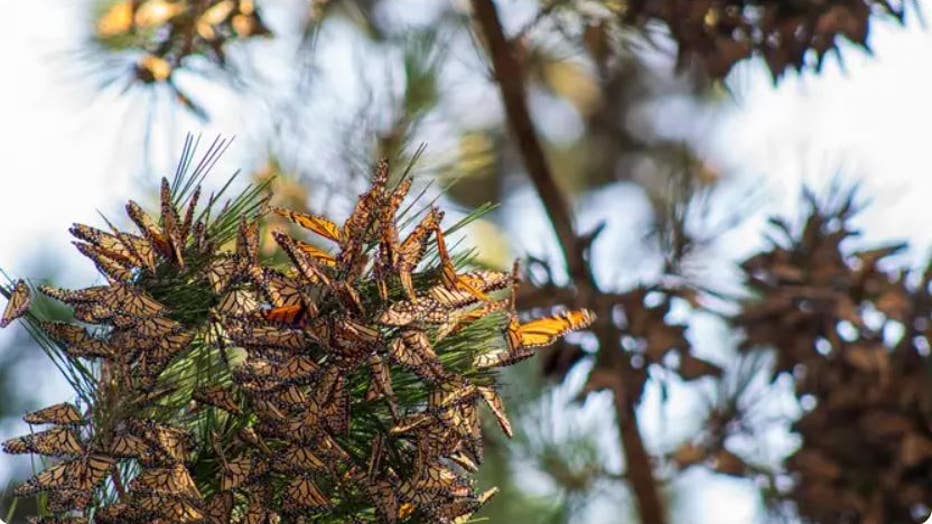
Western monarch butterflies spotted in Pacific Grove, California during the 2022 monarch Thanksgiving count. (Isis Howard/Xerces Society / FOX Weather)
The Western Monarch Count regional coordinator in Monterrey County said the groves in her area showed a 25% drop since Thanksgiving. She said other areas saw a 40% percent drop after the storms. Clusters were entirely gone in some areas.
Storm damage also prevented some observers from going out to the sites.
"On some sites, they're still there in good numbers, and we're hampered because of all the road closures and power outages and flooding. A lot of people just couldn't get out safely," said Pelton, uncertain of the exact drop in numbers.
RELENTLESS CALIFORNIA ATMOSPHERIC RIVERS DROP 32 TRILLION GALLONS OF WATER OVER 3 WEEKS
Over 250 volunteers counted roosts and flutters from 272 overwintering sites across California and Arizona to estimate the population. The Xerces Society for Invertebrate Conservation runs the survey and counted 335,479 butterflies.
Over the winter, the butterflies huddled for warmth in groves of trees and faced day after day of tropical storm-force winds and record rainfall. Many of the trees were non-native eucalyptus which is prone to being blown over in high winds and rooted in saturated soil. Observers reported flooding, downed tree limbs and even entire trees uprooted to Xerces.
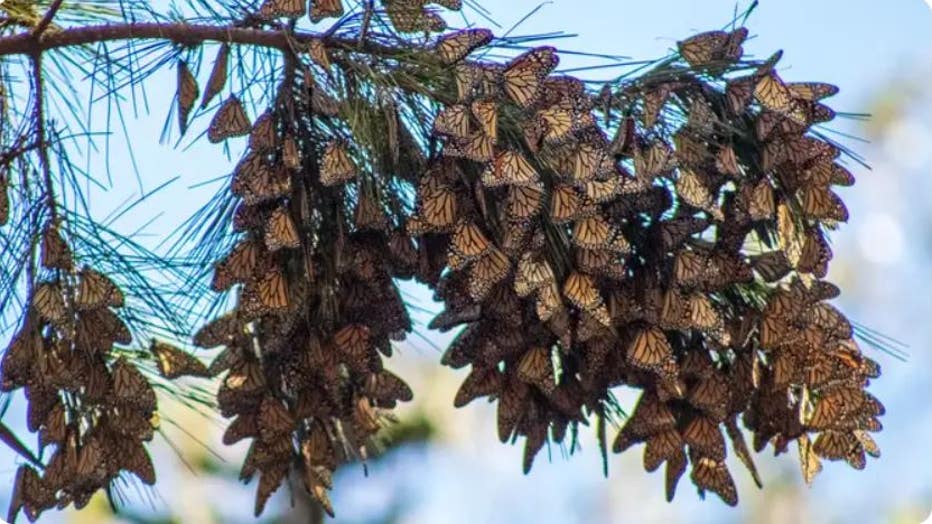
Western monarch butterflies spotted in Pacific Grove, California during the 2022 monarch Thanksgiving count. (Image: Isis Howard/Xerces Society) (Isis Howard/Xerces Society / FOX Weather)
‘Huge mortality’ and ‘storms take it up a notch’
Xerces scientists just started the count in 2017 and are unsure what is historically normal seasonal decline. Throughout years of drought and storms, the population drops have varied from 30 to 50%.
"We do think that there's a pretty big problem happening where we're seeing huge mortality. And these storms take that up a notch," said Pelton. "So we're losing a lot of butterflies. We don't know that it's 100% mortality."
She suggested that butterflies could choose another area over winter. Also, warming temperatures prompted some clusters to start mating and continue the north and eastward migration. One site posted that observers saw mating behavior which signaled an early end to winter.
Protect overwintering sites to withstand storms and droughts
"The plain fact is that if we lose overwintering sites in California, we could lose migratory western monarchs," said Isis Howard, Xerces Society biologist. "Development, eucalyptus removal, and tree trimming all need to be managed thoughtfully if we are to leave space for these animals to survive."
The western monarch population crashed in 2020 to only 2,000 butterflies. The 2021 population rebounded to 250,000. It's a stark contrast to the 1980s when the wintering bugs numbered in the low millions in the West.
"Small populations are particularly vulnerable to being snuffed out by extreme weather, so we are lucky these storms occurred in a relatively good year," said Pelton of the tragedy after a promising initial count. "We don’t want to count on luck alone to ensure the survival of the western monarch migration."
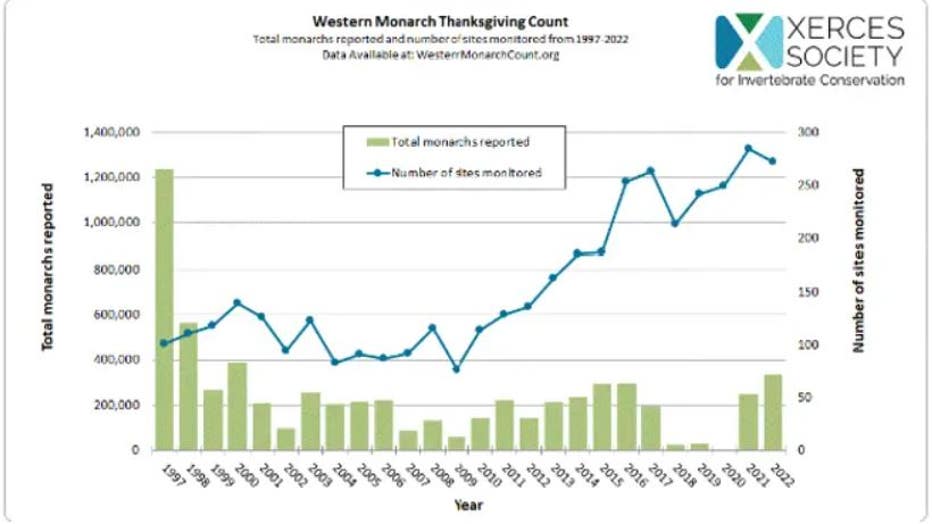
The population (in green) is slowly rebounding after a devastating few years. The blue line shows that Xerces is increasing the number of sites counted each year. (Xerces Society / FOX Weather)
"This is great compared to three years ago. This is not great compared to three decades ago," Pelton said. "We've seen such wild swings in the population over the last five, ten years that I really don't think two good years in a row is an indication of a trend."
The International Union for Conservation of Nature listed migratory monarchs as "endangered," but the butterflies have not been listed in the Endangered Species Act.
MONARCH BUTTERFLIES ARE NOW LISTED AS ENDANGERED

Monarch butterflies, dozens of other species closer to endangered species protections
Noah Greenwald, Endangered Species Director at Center for Biological Diversity, talks about the fight to protect monarch butterflies and other species.
Monarch migration
After spending breeding season to the north and east, the monarchs return to mainly coastal California when the weather gets cold from November to February. Coastal forests offer food of winter flower nectar.
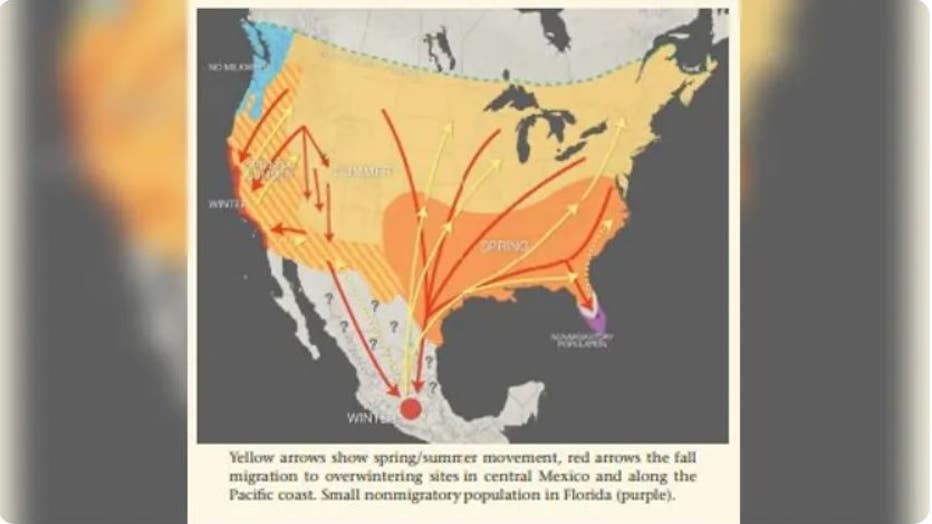
Western monarch butterflies west of the Rocky Mountains migrate to the California coast for winter. Eastern monarchs migrate to Mexico. (The Xerces Society / FOX Weather)
Dr. Arthur Shapiro, Professor of Evolution and Ecology at the University of California, Davis, says there are about 10 core wintering sites in California. He says he doesn’t know what happened to the western monarchs over the past several years.

Fast facts about monarch butterflies
Learn more about migratory monarch butterflies -- the iconic orange-and-black insects that signal spring and summer.
Shapiro doesn’t believe drought, which reduced favored monarch food like milkweed nectar, is to blame for the precipitous drop in numbers.
"What I can say is that Monarch populations had been in long, slow decline before the 5-year drought and rebounded significantly during the drought," Shapiro told FOX Weather in 2021.
MONARCHS MAKE A COMEBACK IN CALIFORNIA
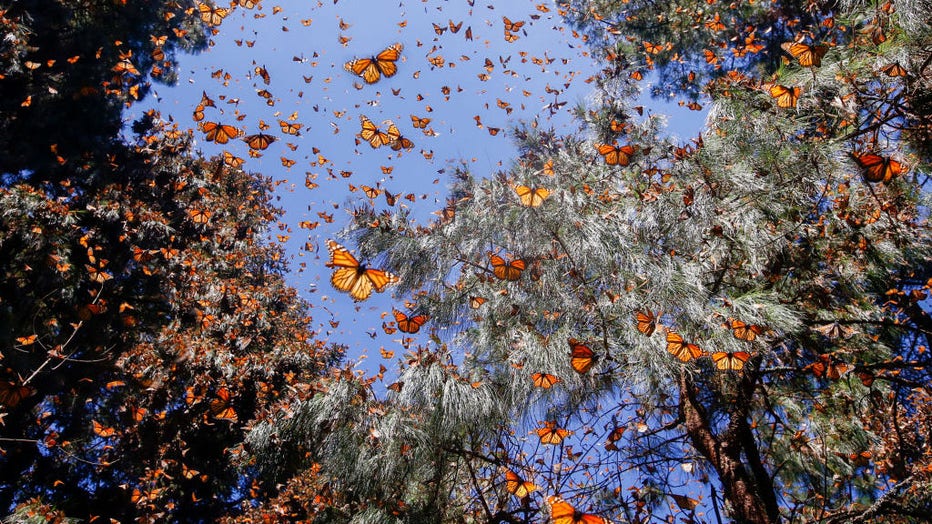
Monarch butterflies are seen in one of their wintering grounds in Angangueo, Michoacan State, Mexico. (Sylvain CORDIER/Gamma-Rapho / Getty Images)
PESTICIDE-FREE MILKWEED FOR BUTTERFLY GARDENS MAY BE HARD TO FIND AT NURSERIES, NEW STUDY FINDS
Shapiro suspects neonicotinoid insecticides may have had a role in the decline. Pesticide use is lower in drought years because many farmers leave their land fallow.
"If pesticides are a cause, I won't say the cause of the declines, this would provide a mechanism to account for improved numbers in dry years," he added.
WHERE IS THE WESTERN BUMBLEBEE? THE SUPER-POLLINATOR DECLINED 57% IN 2 DECADES, SAID STUDY
Neonicotinoid pesticides accumulate in the nectar and pollen of treated crops and turf. The E.U. banned several neonicotinoid insecticides, used on crops and turf in 2013 to protect pollinators like bees.
A recent U.S. Geological Survey study also suggested that the pesticides played a role in the 57% decrease in the occurrence of the western bumblebee.

